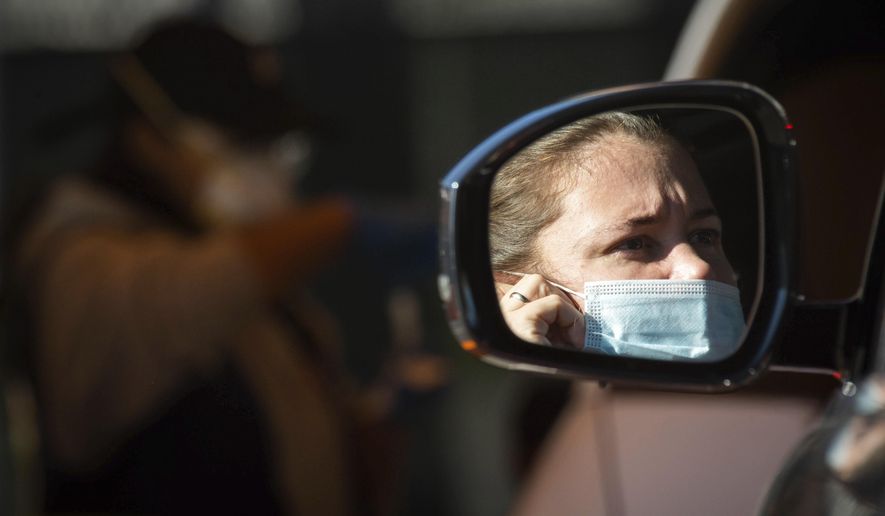Doctors say it is possible for people to be diagnosed with COVID-19 and influenza, but it doesn’t mean the viruses have mingled into a superbug or that it will make someone twice as sick.
The phenomenon, dubbed “flurona” by some, has been reported by health agencies from Los Angeles to Israel, as well as anecdotal accounts from people such as “Duck Dynasty” reality TV star Sadie Robertson.
But doctors said it is not a huge surprise as the world sees an uptick in flu cases after an incredibly mild season last year, when people were staying apart more stringently as part of coronavirus public health protocols.
“Co-infections with COVID and other respiratory viruses, including influenza, have always occurred. With influenza, a co-infection would be most likely in someone not vaccinated against influenza,” said Dr. Amesh Adalja, a senior scholar at the Johns Hopkins Center for Health Security.
Public health officials say COVID-19 has been known to be associated with co-infections, including bacterial and fungal infections, and some people will be more vulnerable to getting both viruses than others.
“The likelihood will be higher in those who are unvaccinated for both of these viruses,” said Saad B. Omer, director of the Yale Institute for Global Health.
He said while it is true that clinicians will confront twin outbreaks of flu and the coronavirus this winter, it is unclear whether co-infection will become a big public health problem. Disease from simultaneous infection is not a know medical syndrome beyond bloggers and headline writers at this point.
“We will learn a lot of things as the season unfolds,” Mr. Omer said.
Maria van Kerkhove, the COVID-19 technical lead at the World Health Organization, warned Monday against using terms like flurona, saying it implies a combination of the viruses and “this is not happening.” She said it wouldn’t be shocking to see both pathogens afflicting the same person.
“With more people mixing with limited use of public health & social measures, PLUS circulation of flu & COVID-19, we will see co-infection occurring,” she tweeted.
Ms. van Kerkhove posted a study by Chinese researchers that found infection with both COVID-19 and the flu had no impact on mortality, suggesting patients weren’t succumbing to more severe disease from the simultaneous attack on the body.
Some researchers have suggested an immune response to one of the infections might help the body to fight the other pathogen, too, though Mr. Omer said that’s “informed speculation” at this point.
Concerns about the twin threat come as the Northeast and other parts of the country suffer from the fast-moving omicron variant that is setting records for daily case counts and putting hospitalizations near last January’s peak, though doctors say the unvaccinated and people who haven’t gotten a booster are bearing the brunt of the disease in their emergency departments.
Deaths have averaged 1,500 per day but remain far below the peak of 3,200 last year as experts hope the omicron wave eases soon, at least in part of the country.
“If you look what’s happening across the East Coast right now in New York City, Washington, D.C., Maryland, probably Florida as well, have already peaked, maybe Delaware and Rhode Island. You’re going to start to see that in the statistics this week. You’re going to start to see those curves, those epidemic curves bend down,” former Food and Drug Commissioner Scott Gottlieb told CBS’ “Face the Nation” on Sunday. “The risk right now is to the Midwest, where you have rising infection, where they aren’t in the thick of their omicron wave yet.”
Dr. Gottlieb said hospitalizations are not rising as fast as infection rates “but cases are up substantially, so it’s pressing hospitals. Many of the hospitals on the East Coast are going to reach or surpass their previous hospitalization totals.”
At the same time, the Centers for Disease Control and Prevention said in a weekly report that levels of flu are increasing in the eastern and central parts of the country, while western states report lower levels. It said flu is “still low nationally, but CDC surveillance systems continue to detect slow but steady increases in flu.”
Flu killed between 12,000 and 52,000 Americans annually between 2010 and 2020, though last year’s season was a historical anomaly as people stayed home or masked up, resulting in a mild flu season and an estimated 750 deaths.
“This year’s flu season will not be like last year’s nonexistent flu season but it will be milder than prior flu seasons,” Dr. Adalja said, as many people still take some precautions.
The CDC’s surveillance system, which provides preliminary estimates, found that 730 to 2,200 people died from flu in the U.S. between Oct. 1 and Jan. 1.
Ms. Robertson, of “Duck Dynasty” fame, reported in an Instagram post feeling “exhausted” after starting off the year with “FLURONA.” She also said a rat invasion of her home had made the situation worse.
For more information, visit The Washington Times COVID-19 resource page.
• Tom Howell Jr. can be reached at thowell@washingtontimes.com.




Please read our comment policy before commenting.